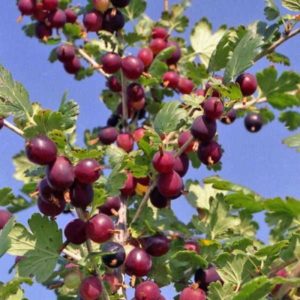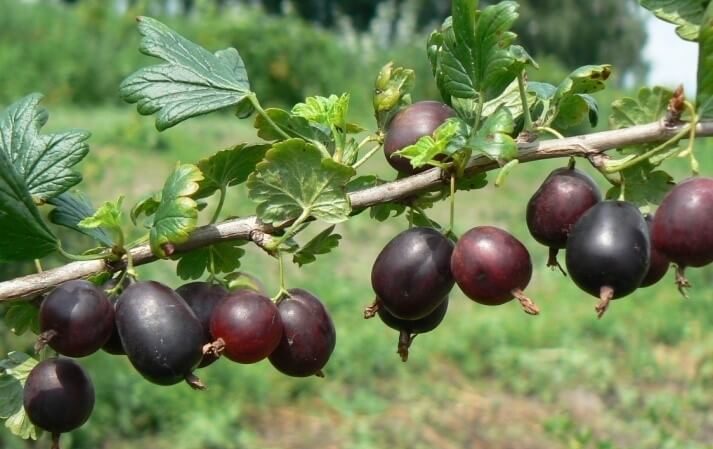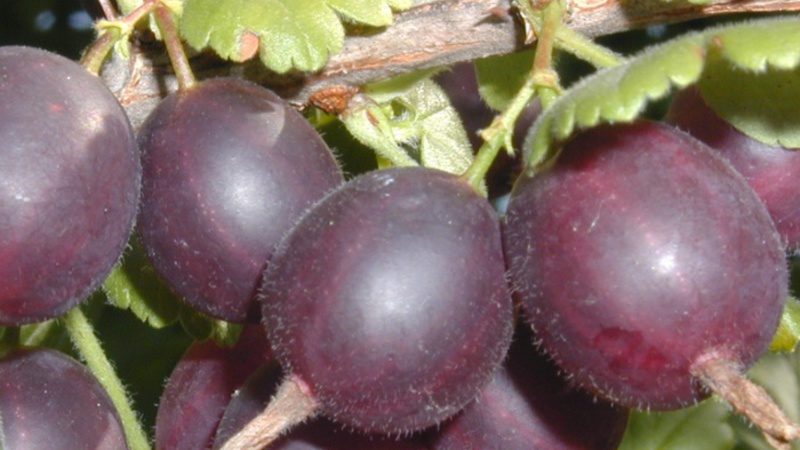Review of the gooseberry variety “Northern Captain”, its pros and cons
Of the variety of gooseberry varieties, Northern Captain stands out for its unpretentiousness and productivity. In addition, the hybrid is ideal for growing in harsh climatic conditions. The article discusses the characteristics of the variety, its care and possible difficulties that may prevent you from getting a good harvest.
What kind of gooseberry is this?
Northern Captain is a thornless mid-late gooseberry variety with high frost resistance and tasty fruits.
Brief history of origin and distribution
The variety was developed by Russian VSTIPS breeders under the leadership of Irina Popova through an experiment of crossing the variety Rozovy-2 and form No. 310-24. In 2007, the resulting hybrid, called Northern Captain, was included in the state register with the indicated zoning - the North-Western region with cloudy, damp summers.
Characteristics and description of bushes

Northern captain is a perennial tall shrub with a dense crown. Under the weight of ripe fruits, young green shoots bend like an arch, and adult stems become lignified and acquire a gray tint.
The variety has short, 5-7 mm, thorns, which are rarely found on adult branches and are completely absent on young ones. The spines are straight and thin, formed exclusively at the base of the shoots. The foliage is a rich green hue, large in size, with a glossy surface and three-lobed shape.
The variety is characterized by greenish flowers with a red streak along the edge, collected in small brushes (2-3 flowers each).
Temperature resistance
In winter in northwestern Russia, temperatures often drop to -30°C. The northern captain is able to withstand such frosts provided they are hilled and mulched. It is not afraid of strong winds, and does not need shelter for the above-ground part.
Intense heat with a lack of watering can partially destroy the bush. Therefore, it is not recommended to grow this variety in hot summer conditions; after +30°C, the harvest may suffer.
Moisture and drought resistance
Gooseberry roots are shallow, so prolonged drought negatively affects the health of the plant, and part of the bush may die. If there is not enough natural rainfall, the roots may dry out. This should not be allowed, especially during the period of laying or filling fruits. But it is also important to avoid stagnation of water. Groundwater should be located no higher than 1.2 m.
Resistance to diseases and pests
Strong immunity is a distinctive feature of the Northern Captain. The shrub does not suffer from powdery mildew, and cases of septoria and anthracnose are extremely rare. Gardeners claim that the main enemies of gooseberries - the sawfly and moth - bypass the variety.
Characteristics and description of fruits

The berries of the Northern Captain are small, ranging from 3.5-4 g. They have a rich dark red or burgundy color, sometimes turning into a black tint. The peel is thick, with light veins, and covered with a thin waxy coating. The pulp is juicy and sweet and sour, with small seeds.
The variety is self-fertile and does not require pollinating varieties. The Northern Captain shows its qualities best in the regions for which it was bred.The berries ripen evenly, at the end of July, so the variety is classified as mid-late. Ripe fruits are easy to harvest, but do not fall off on their own. Up to 3.5-4 kg of berries are harvested from an adult bush.
With proper care and regular pruning, the bushes consistently bear fruit for up to 20 years.
Reference. The northern captain consistently forms ovaries and brings up to 2 kg of harvest even in the absence of quality care.
Areas of their application
The northern captain is considered universal. Its berries have a distinct sweet and sour taste, so many people consume them exclusively fresh. In addition, jam, jam, compotes, wines and juices are made from them, and a natural dye is obtained.
Advantages and disadvantages of the variety

The northern captain has many advantages:
- ability to withstand frosts down to -30°C without loss;
- strong immunity to major diseases and pests;
- Thanks to the thick peel, it tolerates storage and transportation well;
- the berries do not fall off and are easy to pick due to the absence of thorns;
- reproduces by all vegetative means;
- versatility of fruit use.
Among the disadvantages, gardeners note:
- strong thickening with young shoots;
- small berry size;
- the sourness characteristic of gooseberries, which is why the variety was classified as a technical variety rather than a dessert variety.
Growing technology
Agricultural technology for this variety is standard. In zoning areas, it does not require frequent watering, special preparation for winter and worries about diseases.
Optimal conditions
For landing For the northern captain, a site with good lighting and protection from drafts is selected. It is important that when the snow melts, melt water does not accumulate on the beds. The soil should be nutritious and loose, with neutral acidity.
Landing dates and rules
It is best to plant young plants in the fall, adjusting to weather conditions so that the seedling has time to take root before persistent cold weather begins. It is better not to plant in spring - the sprouts may suffer from return frosts.
The seedling must be two years old, with woody roots and flexible, healthy shoots. Planting is done as follows:
- The root system of the seedling is soaked for 2-3 hours in a stimulator (for example, “Kornevin”).
- A hole of 50x50 cm is prepared for each bush. 1.5 m is maintained between bushes, 2-2.5 m between rows.
- Some of the soil is mixed with humus and returned to the hole, being careful not to compact it too much.
- The seedling is placed in a planting place, gradually covered with earth and compacting it.
- The root collar should be immersed 6-8 cm in the soil, otherwise the seedling will die.
- The bush is watered with 10 liters of water, after which the shoots are cut off, leaving 5-6 buds on each.
In addition to humus, upon landing use a mixture of compost, potassium and phosphorus fertilizers. Experienced gardeners recommend adding a little sand and wood ash to the soil (250 g for each bush).
Further care
In order for a seedling to grow well and produce a stable harvest, it requires proper care. It includes the following agricultural practices:
- Watering. In the north-west of Russia, in areas where the variety is zoned, Northern Captain does not experience a lack of moisture, receiving it from natural precipitation. In spring, the plant wakes up early and uses melt water to grow. In rainy summers, gooseberries are not watered, but if there is not enough rainfall, 10-15 liters of water are poured under each bush once a week, preventing the roots from drying out.
- Top dressing. For the first two years after planting, the gooseberry needs only the fertilizers that have already been added to the soil. In the future, bushes are a must feed in the spring, using a mixture of 10 kg of rotted manure, 80 g of superphosphate, 40 g of nitrate and 20 g of potassium chloride.
- Loosening. In a rainy summer, caring for the Northern Captain can only come down to weeding and garbage collection. Remember that gooseberry roots are shallow, so only loosen the top layer of soil. They do this after every rain or watering, simultaneously removing stones, branches and other debris.
- Trimming. Since young shoots thicken the crown every season, gooseberries need to be pruned regularly. From the second to the fourth year, formative pruning is done, shortening the adult branches by half. Crooked, dry or weak branches are removed completely. From the fifth year, crown thickening is eliminated, leaving 20-25 shoots aged from 3 to 6 years. Older branches practically do not bear fruit and only draw strength from the bush. Pruning is done in the fall, after the leaves have fallen.
Possible problems, diseases, pests
The northern captain is a resistant berry crop, so it is not afraid diseases and pest infestations. It is enough to carry out preventive measures in a timely manner and there will be no problems with growing this gooseberry.
Important. After pruning the bushes, fallen leaves and eliminated shoots are burned outside the site. This will prevent pests and bacteria from successfully overwintering and causing damage to the planting next season.
Preventive measures include the following:
- In the spring, before the buds swell, the branches of the Northern Captain are watered with hot water from a watering can.
- Twice a season, before flowering and after harvesting, each bush and the ground under them are treated with Fitosporin-M solution, according to the instructions on the package.
- Remove branches, leaves and other debris in a timely manner.
- You can plant mint, tomatoes or wormwood next to the gooseberries. These plants repel insects.
- At the first signs of the disease, the affected branches are cut off and burned, and the bushes process Bordeaux mixture (100 g per 10 l of water) or wood ash solution (200 g per 10 l).
Wintering
The variety is frost-resistant, so it does not need additional shelter. It is enough to hill it up and then mulch it with rotted manure.
Reproduction
The northern captain reproduces by all vegetative methods, but the following three are the most effective:
- dividing the bush;
- using cuttings cut in early summer;
- propagation by layering.
The easiest way is propagation by layering. In the spring, a small groove is made under the bush into which the shoot is placed. It is sprinkled with earth, leaving only the top on the surface. The soil around the stem is kept moist. Over the summer, roots will appear on the branch, after which the cuttings can be transplanted to a permanent place.
Dividing the bush is suitable when transplanting an adult plant to another area. The planting rules for this method of propagation do not differ from planting a young seedling.
When propagating by cuttings at the beginning of summer, it is necessary to cut a shoot up to 15 cm long from the bush, which is planted in the ground or container with fertile soil. Throughout the season, it is cared for as usual, regularly watering and loosening the soil, and after roots appear, in early autumn, it is transplanted into a prepared hole.
Features of growing this variety, depending on the region
Northern captain does not require careful care - you only need to perform basic agricultural techniques. However, in warmer climates it needs regular watering - at least 10-15 liters of water per bush.
Reviews from summer residents

Due to the large number of positive qualities, the Northern Captain gooseberry variety is popular among summer residents, despite the young age of the crop.
Elena, Karelia: “Winters in our region are harsh, with strong winds. The northern captain tolerates frost well and is able to recover even if the shoots are damaged by the cold. The sourness of the fruit makes this variety an ideal ingredient for jams and preserves. If you are not lazy and carry out regular pruning, the gooseberry will delight you with a rich harvest and will not get sick.”
Oleg, Novgorod region: “This is not the first gooseberry variety on my site. The previous two suffered greatly from powdery mildew, which avoids the Northern Captain. From each bush I collect 4 kg of berries, make jelly and liqueur from them. I don’t cover it for the winter; the variety doesn’t need it, restoring itself in the spring. Definitely an ideal crop for harsh climates.”
Valentina, Kamchatka: The climate on our peninsula is very unpredictable. Often, return frosts kill hope for harvest from many crops. In the fifth year of growing Northern Captain, unexpected frosts struck during the flowering period. She covered the bushes with film with small holes for air, and wrapped them in burlap on top. At the end of summer I harvested a decent harvest, so I’m happy with the variety, its frost resistance is excellent.
Conclusion
Northern captain gooseberry is one of the best representatives of its species.It is distinguished by high frost resistance and strong immunity, is not demanding in care and bears fruit consistently for 20 years. With proper watering and timely pruning, you can get a rich harvest of sweet and sour berries, which are consumed fresh and used in homemade preparations.